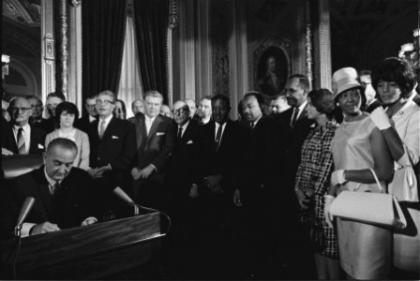Constitution Check: Do the states have a right to be treated equally?

Lyle Denniston looks at some long-range implications from the Supreme Court’s Voting Rights Act ruling on other states-rights issues.
THE STATEMENTS AT ISSUE:
“Over a hundred years ago, this court explained that our nation ‘was and is a union of states, equal in power, dignity and authority.’ Indeed, ‘the constitutional equality of the states is essential to the harmonious operation of the scheme upon which the Republic was organized.’…The fundamental principle of equal sovereignty remains highly pertinent in assessing subsequent disparate treatment of states The Voting Rights Act sharply departs from these basic principles.”
– Chief Justice John G. Roberts, Jr., writing for the Supreme Court majority last month as the court struck down a key part of the Voting Rights Act of 1965, in the case of Shelby County v. Holder.
“The court pins its result, in large measure, to ‘the fundamental principle of equal sovereignty.’…However, the court [previously] held, in no uncertain terms, that the principle ‘applies only to the terms upon which states are admitted to the Union, and not to the remedies for local evils which have subsequently appeared.’…Today’s unprecedented extension of the equal sovereignty principle outside its proper domain – the admission of new states – is capable of much mischief. Federal statutes that treat states disparately are hardly novelties.”
– Justice Ruth Bader Ginsburg, writing for the dissenters in the Shelby County case.
WE CHECKED THE CONSTITUTION, AND…
When James Madison was working on drafts of the proposed Constitution, he suggested that there be a provision for bringing in new states, beyond the original 13. His draft suggested that any new state “shall be admitted on the same terms with the original states.” That idea got some support during the Philadelphia Convention, but the final version – part of Article IV – said only that “new states may be admitted by the Congress into this Union.”
When the third new state, Tennessee, joined the Union in 1796, Congress explicitly declared for the first time that Tennessee’s entry would be “on an equal footing.” Other new states have been given the same promise. The most enthusiastic Supreme Court embrace of that idea came in a 1911 Supreme Court decision, Coyle v. Smith. But, that, too, was in the context of the rights that states would have at the point of becoming part of the United States.
In recent times, the Court had only hinted – that is, until last month – that it would rely upon that principle to protect the equality of the states from differing treatment by Congress. The broadest hint (though few observers paid much attention to it at the time) came in 2009, in the case of Northwest Austin Municipal Utility District v. Holden.
In that case, Chief Justice Roberts wrote a strongly worded opinion suggesting that the Voting Rights Act of 1965 might at some point be declared unconstitutional because it “differentiates between the states, despite our historic tradition that all the states enjoy ‘equal sovereignty.’ ”
There was, though, a very good reason that the comment caused little stir then: the Court in that ruling shied away from striking down the law; it found another reason to decide the case. As a result, the Chief Justice’s mention of “equal sovereignty” would be regarded as what lawyers call “dictum” – a statement not essential to the ruling, so not binding.
But, as often happens in Supreme Court decisions, “dictum” or a passing comment in an earlier opinion can suddenly gain more stature later, when it is turned into a binding declaration of law, including constitutional law.
That, in fact, is exactly what happened on June 25, when the court majority did, indeed, strike down a key part of the 1965 voting law. Invalidated was the formula that Congress had first written in the original Voting Rights Act to single out some states (mostly in the South) for new limitations on their power to pass election laws, because of their history of racial discrimination in voting.
With Chief Justice Roberts again writing for the majority, in the case of Shelby County v. Holder, the court relied upon the doctrine of state equality as a critical part of its ruling. The opinion relied explicitly on the broad language used in that 1911 decision in Coyle v. Smith.
If the dissenting Justices’ reading of history is correct, that marked the first time that the states had been given an explicit constitutional promise of equality at any point after they had joined the Union.
As it happens, the court’s reliance on the equal states’ concept emerged in the midst of what might be called a new “federalism” revolution – that is, a time of new emphasis on states’ rights, stirred in considerable part by the Tea Party movement’s resistance to the growing powers of the national government.
It would be no surprise, then, if state attorneys general now begin to explore new ways to challenge federal laws that they might regard as treating their state differently, without justification. If Justice Ginsburg was correct in saying that a federal law that singles out some states for different treatment is “hardly novel,” then some state officials may start a campaign of resistance to some of those laws. Ginsburg’s opinion asked: “Do such provisions remain safe given the Court’s expansion of equal sovereignty’s sway?”
She did not answer, but perhaps an answer may not be long in coming.
Lyle Denniston is the National Constitution Center’s adviser on constitutional literacy. He has reported on the Supreme Court for 55 years, currently covering it for SCOTUSblog, an online clearinghouse of information about the Supreme Court’s work.
Recent Constitution Daily Stories
10 fascinating facts about the Declaration of Independence

